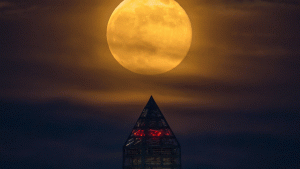The moon will seem a little bit bigger and brighter Saturday morning when a “supermoon” — the first of an expected three this summer — will be visible, according to NASA.
The occurrence, also called a “perigee moon,” takes place when the moon becomes full at the point of orbit when it’s closet to earth, making the moon “seem extra big and bright,” NASA reported on its website.
The supermoon will be visible all weekend, but will be at its fullest point at 4:25 a.m. local time on Saturday, according to The Farmer’s Almanac.
In addition to July 12, supermoons were also expected to occur on Aug. 10 and Sept. 9, NASA stated.
The moon on Aug. 10 will become full in the same hour as perigee, which could make it an “extra-super moon,” according to NASA.
This is the second year in a row where three perigee moons would be visible over a period of three consecutive months, Geoff Chester of the U.S. Naval Observatory told NASA.

“Generally speaking, full moons occur near perigee every 13 months and 18 days, so it’s not all that unusual,” he said.
The supermoon last June made headlines because it was 14 percent bigger and 30 percent brighter than other moons in 2013, the website stated.
However, according to NASA, it is not always easy to tell the difference between a regular moon and a supermoon.
“A 30 percent difference in brightness can easily be masked by clouds and haze. Also, there are no rulers floating in the sky to measure lunar diameters,” the post on NASA’s website stated. “Hanging high overhead with no reference points to provide a sense of scale, one full moon looks about the same size as any other. ”
The moon on Aug. 10 will become full in the same hour as perigee, which could make it an “extra-super moon,” according to NASA.






